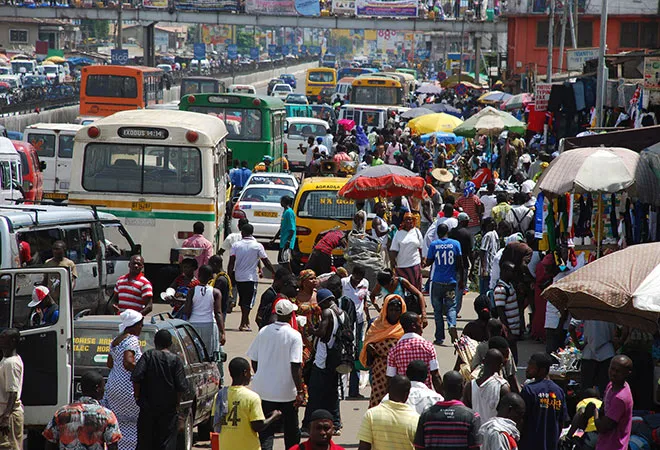
Among the world’s all continents, Africa is the least urbanised: in 2010, it was estimated that only about 36% of the continent was ‘urban.’ This is comparable with India’s urbanisation levels, which stand slightly lower — in 2011, it was estimated that 32% of the country was ‘urban.’ However, despite having the lowest urbanisation in the world, the rate at which Africa is being urbanised — around 3.5 % per year over the last two decades, which is expected to hold till 2050 — is the most rapid in the world. This will propel it to become a major urban landmass in the next 15 to 20 years.
If Africa’s development is handled wisely, it can bring about unprecedented transformation in the country — higher economic growth, reduction of poverty, better economic equality and a much higher standard of living and quality of life are all likely outcomes. Alternately, it could replicate the problems that are witnessed in much of the developing world. For example, there could be more capital but heightened inequality, less absolute poverty but poor housing manifested in the proliferation of slums, more traffic congestion and the absence of public transport, poorer environment conditions and a run-down infrastructure. The overall challenge, therefore, is to get urbanisation right by learning from other developing countries and contextualising them in the African socio-economic milieu. India, specifically, should be looked to as a reference for many of these aspects.
Despite having the lowest urbanisation in the world, the rate at which Africa is being urbanised — around 3.5 % per year over the last two decades, which is expected to hold till 2050 — is the most rapid in the world.
Indian and Africa have similar demographies: The current African population is estimated at 1,315 million and India’s at 1,368 million. Both show clear signs of ‘urban primacy’ — i.e. a few cities that have an economic activity and a political weight which is several times greater than the next largest class of cities. The UN’s The World’s Cities in 2016 reported five Indian cities and three African cities to have crossed the 10 million mark. Meanwhile, Africa has over 40 cities that houses a population of one million and above, so does India with 40 cities that are million plus in population. Thus, the two regions have similar levels of urbanisation and similar factors propelling a comparable phenomenon.
Both in India and Africa, urbanisation is inter-alia, fueled by rural migration that floods cities and puts urban local bodies under extreme pressure to quickly harness policies and processes that will integrate migrants into cities. Both face larger migrations to their primary cities since they have stronger economies capable of generating jobs. This does not mean that formal jobs are on offer; rather, the unskilled populations can make a living in the informal sector. It is estimated that in Africa 93% of new jobs and 61% of all jobs are in the informal sector. India is not far behind — an estimated 86% of jobs is absorbed by the informal sector.
Both in India and Africa, urbanisation is inter-alia, fueled by rural migration that floods cities and puts urban local bodies under extreme pressure to quickly harness policies and processes that will integrate migrants into cities.
The similarity extends further. For a long time, Indian cities have struggled to provide planned space for the informal sector, leading the migrants to use footpaths, streets and places unmarked for commerce to carry on their small, informal enterprise. Africa faces the same situation, and is also shaped by unplanned and unregulated growth, and a lack of physical, economic and social infrastructure such as potable water, public transport, public health and educational facilities, insanitary environment, insecurity and crime and subhuman conditions of living. Overall, the inclusive growth appears to be seriously compromised.
Urban governance has been a further casualty. In India, as in Africa, laws inherited from the colonial period have left urban local bodies powerless. The municipal statutes and planning laws did not allow the empowerment of urban local governance and there was a significant centralisation and concentration of power at higher echelons of the government leading to huge deficits in rapid decision-making. The municipal bodies found the capacity of their human resource eroded. These and several other factors disabled local bodies from rising to the challenges of urbanisation.
In India, as in Africa, laws inherited from the colonial period have left urban local bodies powerless.
While many of these weaknesses still remain in India, the country has now become more engaged with planned urbanisation. In 1992, the Indian Parliament passed the Constitution (seventy fourth) Amendment Act for the empowerment of urban local bodies so that they could become self-governing institutions. This was a path-breaking reform in the nation’s urban governance. State governments such as Maharashtra implemented the Sites and Services Scheme in the 80s to improve the living conditions of slums by providing basic services such as water, roads, electricity, sanitation, toilets and street lights. Several other schemes were set up to fix the housing problems of the poor — the latest in the series is the Prime Minister’s programme of Housing for All. In 2014, the Indian government brought in The Street Vendors (Protection of Livelihood and Regulation of street Vending) Act, which recognised street vending as a legitimate trade and offered protection to street vendors who were in danger of being evicted. Additionally, The Smart Cities Mission, launched in 2015, aims at building one hundred smart cities across India. The Urban Sanitation Mission aims at universal sanitation coverage and a complete end to open defecation. The National Urban Livelihoods Mission assists gainful self-employment to the unemployed.
The above cited steps are a few significant initiatives and are in line with UN’s SDG goal of making cities “inclusive, safe, resilient and sustainable.” Africa is also attempting its own initiatives. For instance, in 2012, the fourth African Ministerial Conference on Housing and Urban Development (AMCHUD4) prepared a strategy document titled Optimizing the Urban Advantage. This document drew its inspiration from the African Union’s Agenda 2063, and strategised how urbanisation in Africa could be a force for the structural transformation. These initiatives and other national level initiatives in Africa could go a long way in assisting the continent to adopt a broader development lens beyond rural-development. Thus, while its past was rural, the African future decidedly requires a rural-urban dialogue; if this potential is realised, development could be inclusive, safe, resilient and sustainable.
The views expressed above belong to the author(s). ORF research and analyses now available on Telegram! Click here to access our curated content — blogs, longforms and interviews.




 PREV
PREV


